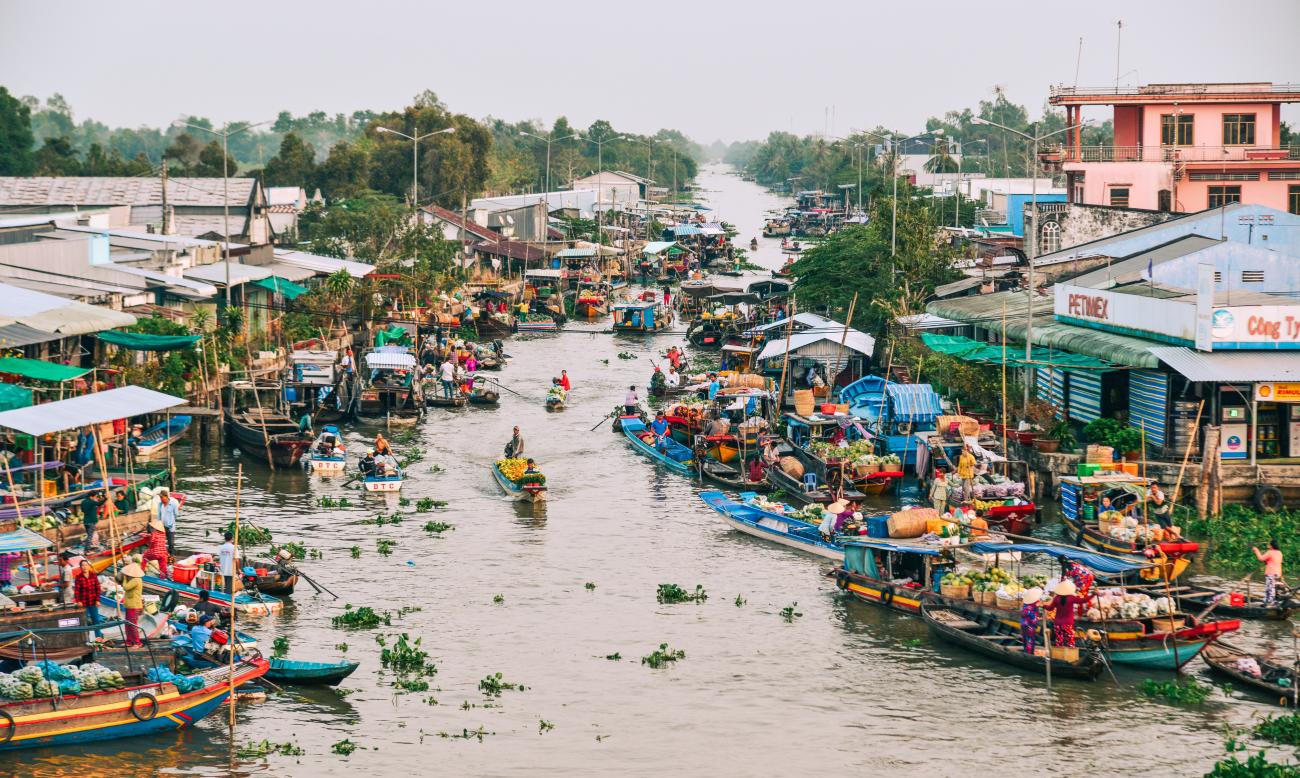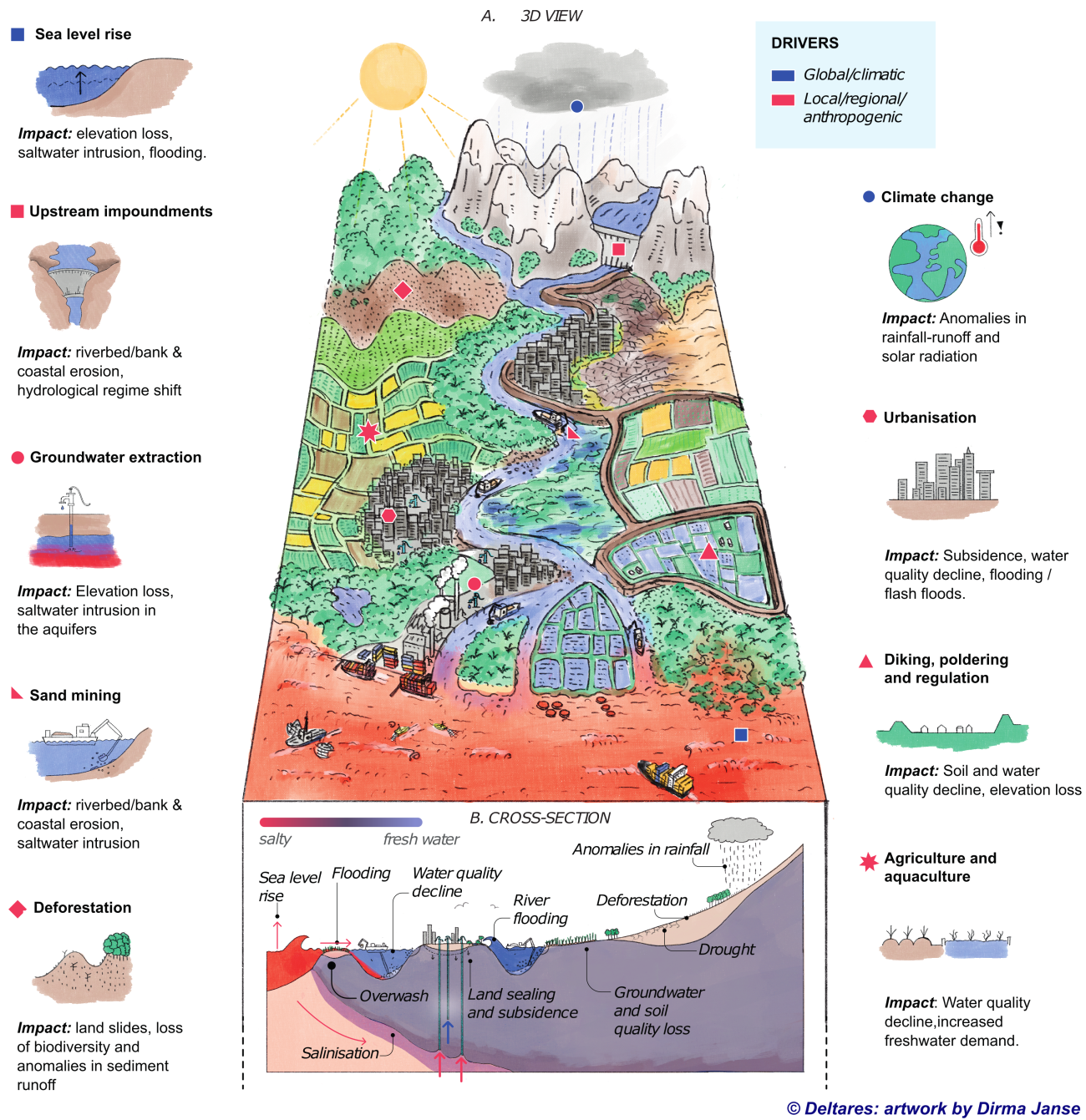New research identifies the key causes of changes affecting river deltas around the world and warns of an urgent need to tackle them through climate adaptation and policy.
Deltas are low-lying areas that form as rivers empty their water and sediment into another body of water, such as an ocean or lake.
Some of the largest in the world, such as the Rhine, Mekong, Ganges-Brahmaputra-Meghna, and Nile, are threatened by climate change, facing rising sea levels and increasing frequency of extreme events.
With approximately 500 million people today living within or adjacent to delta systems, this is a major issue.

Nga Nam Floating Market in Mekong Delta, Vietnam
To address this, a team of international scientists has developed a new framework that identifies the 10 main drivers of change in deltas globally. These are: climate change, sea-level rise, deforestation, intense agriculture, urbanisation, impoundments, land subsidence, ground water extraction, flood defences, and extensive mining of resources.
Most local, human-induced causes show measurable impacts within years, and the framework provides a clear basis for prioritising timely, locally grounded action with a deeper understanding of the systems that shape these complex and dynamic environments.
Their findings have been published today in Nature Climate Change. The team includes scientists from the Environmental Change Institute at the University of Oxford and the Universities of East Anglia (UEA), and Southampton in the UK, and Deltares, TU Delft, Wageningen University and Utrecht University in The Netherlands.
Dr Amelie Paszkowski, an Honorary Research Associate with the ECI’s Oxford Programme of Sustainable Infrastructure Systems (OPSIS), and former DPhil student at the ECI - and now Water Specialist at the World Bank - said:
Decision making in deltaic systems is extremely difficult due to all the complex interactions between different processes, but this framework helps to disentangle these dynamics and diagnose the challenges present in a delta system, which is fundamental in defining adaptation solutions that address the root causes of deltaic challenges.”
The researchers say deltas are the most complex coastal systems in the world and recognising these multiple drivers and how they operate in each delta is fundamental to finding solutions. They say their research shows that while climate change is a critical factor, local anthropogenic drivers such as sediment starvation and land-use changes often produce measurable impacts within just a few years or decades, and understanding these human footprints is essential to building resilient delta futures.

Effective adaptation requires more than isolated measures, that often overlook an important step in deeper assessments of the system as a whole.
The diagnostic framework links these drivers of change with their direct and indirect impacts across scales in time and space (divided in centuries, decades or temporal scales). It is intended to support policymakers, technocrats, engineers, and stakeholders in developing locally grounded adaptation strategies that are both realistic and resilient.
It aims to help identify and understand the interconnectivities within the biophysical system, from source to sink, and how these link with local/regional/transboundary socio-economic structures.
The diagnostic framework can also foster constructive dialogue among stakeholders and ensure that adaptation efforts are both science-based and socially relevant. Dr Sepehr Eslami, lead author and coastal expert at Deltares, said:
If we want to give deltas a real chance at long-term climate resilience, we need collective comprehension of the human footprint and the underlying drivers of change.
By promoting system-level thinking, this framework encourages more critical and collaborative approaches to adaptation. It helps identify the solutions with the highest chance of being implemented successfully, especially when embedded in a longer-term vision.”
The research was inspired by the work of the Rise and Fall Project, a collaboration between Deltares and the Utrecht University, and also involved researchers from the University of Cologne and University of Padova.
Over a period of nearly three years, the team combined decades of knowledge on vulnerabilities in deltas and adaptation efforts to develop a framework that can facilitate diagnosing the key processes and interactions shaping a delta system. The goal: to offer a holistic foundation for planning effective, context-sensitive adaptation strategies.
Read why they’re urging action in their Comment piece in Nature Climate Change: A systems perspective for climate adaptation in deltas
